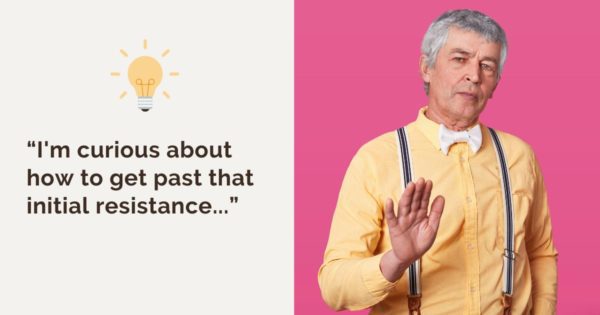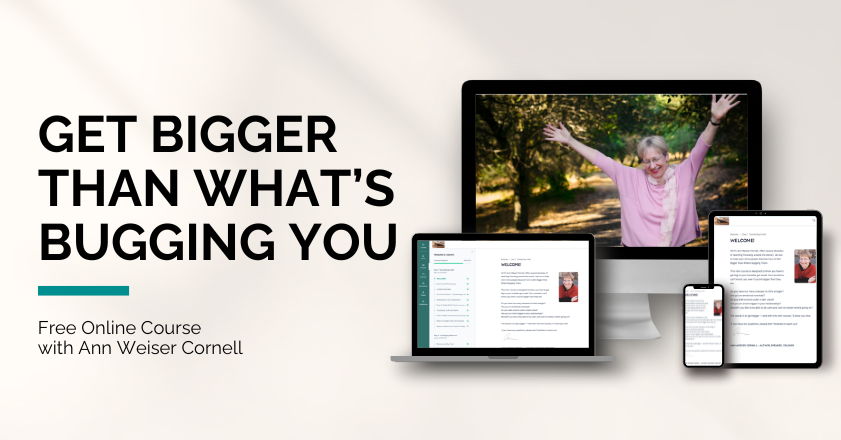Before I get into today’s tip, I wanted to add to last week’s discussion of non-dualistic Buddhist meditation teachers. I realized that the teacher who resonates most with me is someone I know well: the remarkable Russell Delman, who integrates Zen-based meditation with the teachings of Moshe Feldenkrais and what he calls Guided Inquiry. And he has studied with me a lot, so I know he knows Focusing well!
I recommend his lovely website, www.russelldelman.com.
"I feel awkward saying Hello to something I know is me."
~~~~~~~~~~~~~~~~~~~~~~~~~~~~~~~~~~~~~~~~~~
Mary Love writes: "Sometimes clients who are new to Focusing or even my sister who’s taken a course, say ‘I feel awkward saying ‘Hello’ to something I know is me.’ Or…’This talking TO something feels false’ or ‘I feel silly.’ What are some skillful ways to acknowledge that but still encourage that wonderful tool of disidentification and opening: talking to."
Dear Mary Love,
When a person complains that you are trying to have them say Hello to something that feels like "me," it means they don’t have an "it" yet, a "something there." And it is important that there is an "I" and an "it," or we don’t have Focusing. So it’s well worth taking time and giving attention to this key movement.
What is it that comes before saying Hello? A sense of "something there" has to be present we can say Hello to that something.
Let’s say your client who is new to Focusing is telling you about a problem. "My boss criticized my work, and it was not my fault really, it was something John was supposed to do. It was so unfair! I was furious… and I’m still furious right now!"
"You’re feeling how unfair that was! And you’re still furious as you remember it right now."
Wait… why am I NOT suggesting that you say "something in you is furious"? Because people in the grip of emotion are probably not ready yet for "disidentification." They probably first need to be heard exactly as they are.
So now my client says, "Yes! That’s right!" and goes on perhaps to say more. "She’s always doing that to me, and I hate not being able to speak up about it."
Now I might try a subtle offer at disidentification: "Yeah, there’s something about her always doing that… you’re hating not being about to speak up about it."
If my client takes my offer, she’ll begin to look and sound more self-reflective, like she’s slowing down to sense more. "It reminds me of my dad," she might say. "He always did that too, blaming me for what my brother did." She might follow this with a sigh.
"Something is there," I reflect, "about your dad, how he seemed to always blame you for what your brother did."
Now my client is looking down, or her eyes are closing, and her hand drifts to her heart."
"Something there," I say, "maybe where your hand is going now."
"It’s sad," she says. "I thought it was angry, but it’s so sad."
"Ah. You’re sensing it’s so sad."
"It’s right here," she says.
And now, at last, finally, I could invite her to say Hello… but I don’t think I would, in this case. She’s already in the good contact that Hello would bring. I think I’d invite her to just stay with that.
When Saying "Hello" Helps
~~~~~~~~~~~~~~~~~~~~~~~~~~~~~~~~~~~~~~~~~~
It’s good to see that inviting the person to say Hello is NOT an essential part of every guided Focusing session. There are all kinds of reasons why saying Hello might not be right, including:
* when something is vague, not formed enough yet
* when something doesn’t yet feel separate
* when the person is already in a deeper contact that even Hello would bring (as in the example above)
So when WOULD we invite saying Hello?
Saying Hello is especially helpful when there is already a "something there," but the relationship with it needs attention. Inviting a person to say Hello to something felt is essentially inviting a neutrally friendly attitude… and it tends to work better than saying "Now be neutrally friendly to that." 😉
"I’m feeling this strong pushing in my chest. It’s getting stronger!"
"Maybe you could say Hello to that strong pushing in your chest."
"OK, it got a bit calmer when I did that."
Saying Hello can also be helpful when the person is aware of something there, but it isn’t anything that seems alive or likely to communicate.
"The tightness in my chest is just sitting there."
"Maybe you’d like to say Hello to it."
"It doesn’t want to communicate with me."
"Ah! You’re sensing that about it… that it doesn’t WANT to communicate with you."
(Notice how, though declaring itself uncommunicative, the "something" has become noticeably more alive, and this is now a very promising session.)






